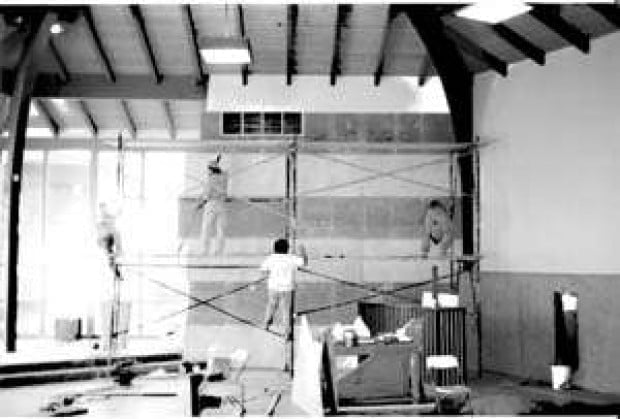If you asked around town where the Malibu Stage Co. theater was located, you might be hard pressed to get a definitive answer. A long driveway and rows of shrubbery and trees hide the building that sits just beyond Heathercliff on the inland side of Pacific Coast Highway. Although it has served in its current capacity for three years, still, many residents may be unaware of the theater that lies much closer to home than those in downtown Los Angeles and in Thousand Oaks.
The building that currently houses the Malibu Stage Co. (MSC) has accommodated tenants ranging from Presbyterian worshippers to various members of the flora and fauna kingdom.
The building was originally used as a church in the 1950s, and after the group left, James Cowan, owner of Cowan & Associates Nursery, purchased it, in conjunction with the land and property adjacent to it, for his nursery.
It was only in the mid-1990s that Charles Marowitz, co-founder of MSC, approached Cowan to see if an arrangement could be made between the two entities.
“The most amazing thing of all,” Marowitz said, “was that when I looked at the place it was completely filled with plants. When I looked in there, things were growing.”
“It struck me, because it is the most obvious place in the world to have a theater,” said the director. “The residents here are in the industry. They are sophisticated. They are bicoastal.”
After Cowan agreed to let Marowitz lease the building for $1,500 a month, it took almost three years to convert it into a theater. From 1996 to early 1999, Marowitz and Jacqueline Bridgeman, co-founder and now president of MSC, brought in seats and sound tiles, and designed a stage.
“The most significant thing is that it was built in such a way that there would be no barrier between the audience and the stage,” Marowitz said.
Bridgeman agrees the quaint former church, with sweeping panoramic views of the Santa Monica Mountains range, is unique.
“It’s the most beautiful 99-seat theater in the United States,” Bridgeman said. “It’s a great space.”
The stage was constructed in a Shakespearean style, which means that half of the building is occupied by the stage and half by the audience. The wrap-around stage is a unique find in smaller theaters. Usually a stage occupies one quarter of the theater and the audience a remainder.
The theater’s 99 seats were obtained in an auspicious manner. They were purchased from the Sands Casino in Las Vegas before it was demolished to make way for a newer casino, and trucked out to Malibu.
The sound in the former church was at a substandard level before renovations, because there were many windows that suited the previous tenants, but were not ideal for a theater.
MSC founders were able to convince a national sound tiling company, A.C. Don, to donate $10,000 in free acoustic tiles in exchange for advertising.
“Now, we have a really good acoustic system,” Marowitz said.
In total, the conversion cost the stage company about $150,000.
The history of the company is uncommon, because it existed before a theater location was found. The company ran shows at Pepperdine’s Smothers Theatre and Raitt Recital Hall and at private residences to raise money for the renovations.
It has also had a tumultuous financial history. Allegations of impropriety regarding the misuse of company funds resulting in an in-house audit, and changing of board members several times have added to the strain of running the company.
In addition to the $1,500 a month in rent, the facility has heating and air condition costs, general upkeeping expenditures and also the expenses associated with each production.
“Small theater is the hardest thing in the world,” Bridgeman said.
Fundraising letters were sent out to Malibu citizens asking them to help get the theater up and running, and Bridgeman stresses the community’s support was invaluable.
Bridgeman has also designed a donation program that features envelopes to be distributed when patrons purchase tickets. Donors have also supported the MSC by purchasing one of the 99 seats in the theater, which is furnished with a plaque honoring the contributor. Also, a grant of $75,000 was released to the company last year to continue its operations.
“It’s something Malibu should be proud of,” Bridgeman said. “The citizens of Malibu own this theater, as far as I’m concerned.”
Bridgeman hopes area residents will discover the jewel that is hidden in their home city. Local actors such as Martin Sheen, Richard Dreyfus and Ed Asner have already picked up the torch for the local theater, participating in plays and readings for MSC.
“The actors in our community are very generous,” Bridgeman said.
In addition to being used for the theater company, in an agreement with the Point Dume Community Service District, which gives the management of the space over to the district, the space is also rented to outside groups for theater-related activities.
The MSC is just now beginning to carve out a regular schedule of plays, and according to Bridgeman, hopes to offer a subscription season this spring. This season opens with “The Last of the Red Hot Lovers,” directed by Christoper Hart.
Bridgeman predicts that, with continued success, the theater will soon be eligible to compete for outside financial assistance.
“We need to get some awards, then we can apply for grants from arts’ foundations.”

